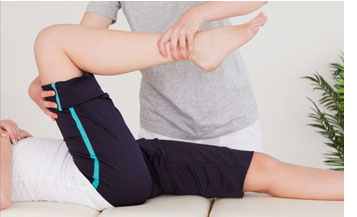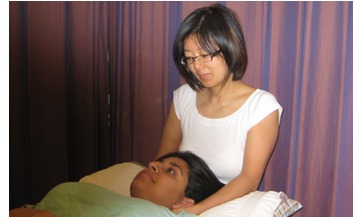Orthopaedic Manual Therapy

- Manual Therapy involves the movement of the joints in the body in order to restore restriction that has been lost due to injury or disease. If you have stiff joints, joint mobilizations and manipulations can help to restore mobility and normal range of motion. Mobilization is the gentle, rhythmic, repetitive movement aimed at restoring mobility and function and reducing pain in a joint and surrounding tissue. Manipulation is a skilled, passive, quick movement to the end of available range of the joint. Manual therapy, therefore, is valuable for the treatment of joints that lack adequate mobility and range of motion in certain musculo-skeletal conditions.
- Orthopaedic Physiotherapy involves determining the range of motion, strength, flexibility, muscle imbalance, endurance and stability in the body. The goal of physiotherapy is to find these physical deficiencies and to correct for them. Thus, assisting in returning you to optimal physical health and conditioning. Orthopaedic physiotherapy also involves therapeutic exercises, joint mobilization, education, postural correction, coordination, balance exercises, as well as taping for activity-specific reasons.
- Massage is performed during a treatment session to relieve muscle stiffness, spasms, or cramps and to help relieve stress, and tension. It can involve rubbing, stroking, or kneading of the muscles. A number of techniques can be used to treat ligaments, tendons, fascia, and other tissues of the body. Myofascial release is a hands-on treatment that helps to release tension in the fascia due to tightness, poor posture, or trauma. Fascia is connective tissues that surround the muscles, bones, nerves and organs of the body. Points of restriction in the fascia can place a great deal of pressure on nerves and muscles causing chronic pain. Myofascial release involves long stretching strokes to balance tissue and muscle mechanics in order to improve joint range of motion and relieve pain.
- Visceral Manipulation (VM) is a gentle hands-on technique that helps the body to release restrictions and unhealthy compensations that cause pain and dysfunction.The word “viscera” refers to the internal organs of the body, such as the liver, stomach and intestines. During VM, the therapist evaluates the entire body to find the source of the problem. She feels for altered or decreased motion within the viscera, as well as restrictive patterns throughout the body. The focus may not be solely on the site of pain or dysfunction. VM therapy re-establishes the body’s ability to adapt and restore itself to health.

5. Craniosacral Therapy (CST): is a gentle, hands-on method of evaluating and enhancing the functioning of a physiological body system called the craniosacral system – comprised of the membranes and cerebrospinal fluid that surround and protect the brain and spinal cord. Using a soft touch generally no greater than 5 grams, or about the weight of a nickel, practitioners release restrictions in the craniosacral system to improve the functioning of the central nervous system. By complementing the body’s natural healing processes, CST is increasingly used as a preventive health measure for its ability to bolster resistance to disease, and is effective for a wide range of medical problems associated with pain and dysfunction, including:
- Migraine Headaches
- Chronic Neck and Back Pain
- Central Nervous System Disorders
- Orthopedic Problems
- Stress and Tension-Related Problems
- Fibromyalgia and other Connective-Tissue Disorders
- Temporomandibular Joint Syndrome (TMJ)
- Post-Traumatic Stress Disorder


